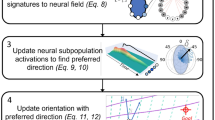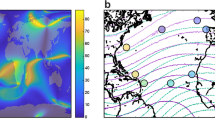Abstract
The Earth’s magnetic field provides a signal that animals and man-made systems can leverage for navigation across long-distances (e.g., continents and oceans). Despite ongoing research in animal magnetoreception, the underlying magnetoreceptors, neural processing, and strategies that ultimately drive behavior are still not well understood. One hypothesis is that animals might use unique or rare combinations of magnetic field properties as a magnetic signature to denote specific locations or regions. While biological observations have provided evidence of this navigation strategy, both the strategy and its underpinnings remain unconfirmed. Software simulations have demonstrated the feasibility of this type of navigation strategy, and a nervous system’s ability to execute it. However, software simulations are limited in the phenomena they are able to properly capture. In this study, expanding on previous work, we implement a magnetic signatures-based navigation strategy in a laboratory-based robotic system. The system consists of a robotic rotary motion platform that serves as a proxy for a navigating animal, a magnetometer for magnetic field sensing, and a computer-controlled magnetic coil system. The system uses neural fields to process magnetic information in a neurally relevant way. The findings demonstrate that nervous system-based processing can successfully enable navigation using magnetic signatures. This lends further credence to the concept of animals using magnetic signatures to navigate, and can provide inspiration for the development of novel man-made navigation and sensor-fusion systems.
Supported in part by a grant from the Air Force Office of Scientific Research (FA9550-20-1-0399).
Access this chapter
Tax calculation will be finalised at checkout
Purchases are for personal use only
Similar content being viewed by others
References
Johnsen, S., Lohmann, K.J.: Magnetoreception in animals. Phys. Today 61(3), 29–35 (2008). https://doi.org/10.1063/1.2897947
Lee, T.N., Canciani, A.J.: MagSLAM: aerial simultaneous localization and mapping using Earth’s magnetic anomaly field. Navigation 67(1), 95–107 (2020). https://doi.org/10.1002/navi.352
Putman, N.F.: Magnetosensation. J. Comp. Physiol. A. 208, 1–7 (2022). https://doi.org/10.1007/s00359-021-01538-7
Lohmann, K.J., Putman, N.F., Lohmann, C.M.F.: The magnetic map of hatchling loggerhead sea turtles. Curr. Opin. Neurobiol. 22(2), 336–342 (2012). https://doi.org/10.1016/j.conb.2011.11.005
Putman, N.F., et al.: An inherited magnetic map guides ocean navigation in juvenile Pacific salmon. Curr. Biol. 24, 446–450 (2014). https://doi.org/10.1016/j.cub.2014.01.017
Naisbett-Jones, L.C., Putman, N.F., Stephenson, J.F., Ladak, S., Young, K.A.: A magnetic map leads juvenile European eels to the Gulf Stream. Curr. Biol. 27, 1236–1240 (2017). https://doi.org/10.1016/j.cub.2017.03.015
Tucker, P.: The Air Force’s latest GPS alternative: earth’s magnetic fields. https://www.defenseone.com/technology/2020/07/air-forces-latest-gps-alternative-earths-magnetic-fields/167387/ (2020). Accessed 22 Nov 2020
Hidalgo, F., Bräunl, T.: Review of underwater SLAM techniques. In: 6th International Conference on Automation, Robotics and Applications (ICARA), Massey University, 17–19 February 2015. https://doi.org/10.1109/icara.2015.7081165
GPS program funding (2021). https://www.gps.gov/policy/funding/. Accessed 30 Oct 2021
Nichols, S., Havens, L., Taylor, B.: Sensation to navigation: a computational neuroscience approach to magnetic field navigation. J. Comp. Physiol. A. 2208, 167–176 (2022). https://doi.org/10.1007/s00359-021-01535-w
Pizzuti, S., et al.: Uncovering how animals use combinations of magnetic field properties to navigate: a computational approach. J. Comp. Physiol. A. 208, 155–166 (2022). https://doi.org/10.1007/s00359-021-01523-0
Taylor, B.K., Johnsen, S., Lohmann, K.J.: Detection of magnetic field properties using distributed sensing: a computational neuroscience approach. Bioinspir. Biomim. 12(3), 036013 (2017). https://doi.org/10.1088/1748-3190/aa6ccd
Wilson, H.R.: Spikes, Decisions, and Actions: The Dynamical Foundations of Neuroscience. Oxford University Press, Oxford (1999). http://cvr-archive.apps01.yorku.ca/webpages/spikes.pdf
Alldred, J.C., Scollar, I.: Square cross section coils for the production of uniform magnetic fields. J. Sci. Instrum. 44(9), 755–760 (1967). https://doi.org/10.1088/0950-7671/44/9/327
Author information
Authors and Affiliations
Corresponding author
Editor information
Editors and Affiliations
Rights and permissions
Copyright information
© 2022 The Author(s), under exclusive license to Springer Nature Switzerland AG
About this paper
Cite this paper
Harvey, A., Taylor, B.K. (2022). A Real-World Implementation of Neurally-Based Magnetic Reception and Navigation. In: Hunt, A., et al. Biomimetic and Biohybrid Systems. Living Machines 2022. Lecture Notes in Computer Science(), vol 13548. Springer, Cham. https://doi.org/10.1007/978-3-031-20470-8_22
Download citation
DOI: https://doi.org/10.1007/978-3-031-20470-8_22
Published:
Publisher Name: Springer, Cham
Print ISBN: 978-3-031-20469-2
Online ISBN: 978-3-031-20470-8
eBook Packages: Computer ScienceComputer Science (R0)




